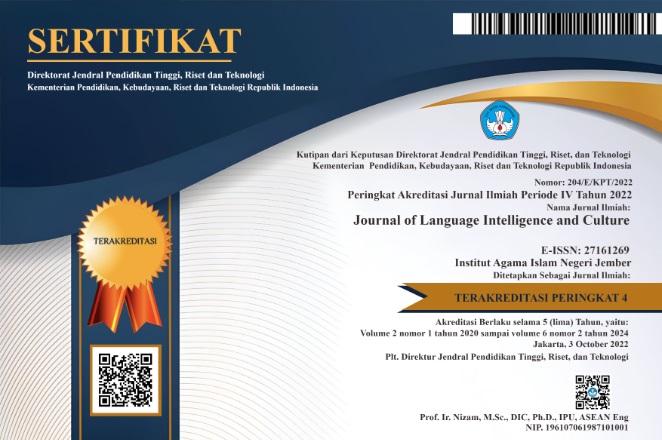Analysis of Foreign Culture Representation in the 10th Grade English Compulsory Textbook
DOI:
https://doi.org/10.35719/jlic.v6i2.138Keywords:
Foreign culture, English textbook, ELT classroomAbstract
Culture is a way of life or outlook that applies in a particular region or community. Through culture, a person will gain an understanding of diverse intercultural matters. This research analyzed the foreign cultural representation in English compulsory textbooks for the 10th-grade students of the senior high school published by the Ministry of Education and Culture of the Republic of Indonesia as an introduction to culture to Indonesian students. This research used a mixed method by using a descriptive approach. The data was collected through analysis of the content in pictures, images, passages, charts, and everything in English textbooks that related to foreign culture representation. Next, data was analyzed by compiling based on the types of culture, dissembling the different types of culture, re-assembling culture based on the right type, interpreting, and concluding. The results showed that the foreign cultural representation on English compulsory textbook consists of four cultural aspects, they are aspect of product culture, aspect of practice culture, aspect of perspective culture, and aspect of person culture. Based on the research results, English teachers must provide a good understanding of foreign cultures to students so they can gain insight into intercultural competence.
References
Anderson, L. W., Krathwohl, D. R., Airasian, P. W., Cruikshank, K. A., Pintrich, P. R., Raths, J., & Wittrock, M. C. (2007). A taxonomy for Learning, Teaching, and Assessing: A Revision of Bloom’s Taxonomy of Educational Objectives. Addison Wesley Longman, Inc.
Arikunto, S. (2010). Metode Penelitian. Jakarta: Rineka Cipta.
Arora, R., & Stoner, C. (2009). A mixed method approach to understanding brand personality. Journal of Product & Brand Management, 18(4), 272-283. https://doi/10.1108/10610420910972792
Brown, H, D. (2000). Principles of language learning and teaching. New York: Longman.
Harmer, J. (2007). The practice of English language teaching. Harlow: Pearson Longman.
Harwood, N. (2010). English Language Teaching Materials: Theory and Practice. Cambridge: Cambridge University Press.
Kang-Young, L. (2009). Treating culture: What 11 high school EFL conversation textbooks in South Korea do. Journal of English Teaching: Practice and Critique, 8(1), 76-96. https://doi/10.5539/jetpc.v8n1p76
Krippendorff, K. (2004). Reliability in content analysis some common misconceptions and recommendations. Human Communication Research, 30(3), 411–433. https://doi.org/https://doi.org/10.1111/j.1468-2958.2004.tb00738.x
Liddicoat, A. J., & Scarino, A. (2013). Intercultural language teaching and learning. West Sussex, UK: Wiley-Blackwell.
Miles, M. B., Huberman, A. M., & Saldana, J. (2013). Qualitative data analysis: A methods sourcebook. Sage Publications Incorporated. https://doi.org/https://doi.org/10.1080/10572252.2015.975966
Moran, P. (2001). Language and Culture. In Teaching Culture: Perspectives In Practices. Boston, MA: Heinle & Heinle.
Prayudha. S, J., Nabila Maratus Salihah, & Ami Pradana. (2023). Integrating Information Communication Technology in English Language Teaching. The Journal Of English Teaching For Young And Adult Learners, 2(1), 29–35. https://doi.org/10.21137/jeeyal.2023.2.1.4
Prayudha S., J. (2021). Video based learning as a media for teaching English during pandemic covid-19. Journal of Language Intelligence and Culture, 2(1), 1–11. https://doi.org/10.35719/jlic.v2i1.53
Prayudha., S., J. (2022). High school English teacher online teaching in rural place: practices and strategies. Jurnal of English Development Vol, 2(02), 10–20. https://doi.org/10.25217/jed.v2i01.2125
Silvia, A. (2015). The representation of culture in English textbooks prescribed for high schools in Indonesia. IJEE (Indonesian Journal of English Education), 2(1), 1-16. https://doi/10.24815/ijiet.v2i1.10023
Song, H. (2013). Diconstruction of cultural dominance in Korean EFL textbook. Journal of Intercultural Education, 24(4), 290–382. https://doi.org/https://doi.org/10.1080/14675986.2013.809248
Soni, A. (2020). Cultural aspects representation in English textbook and its implication on English language learning. Journal of Advanced English Studies, 3(1), 7–15. https://doi.org/http://dx.doi.org/10.47354/jaes.v3i1.82
Sorongan, D., Susanti, R., & Syahri, I. (2014). An analysis of local and target culture integration in English textbooks. LINGUA: Jurnal Bahasa Dan Sastra, 15(1).
Sugiyono. (2014). Memahami Penelitian Kualitatif. Yogyakarta: Alfabeta.
Sulistiyo, U., Wulan, R., Al Arif, T. Z. Z., Efriza, D., & Anwar, K. (2021). A critical content analysis of english textbook for senior high school students in indonesia. Studies in English Language and Education, 8(1). https://doi.org/10.24815/siele.v8i1.16778
Syahri, I., & Susanti, R. (2016). An analysis of local and target culture integration in the English textbooks for senior high school in Palembang. Journal of Education and Human Development, 5(2). https://doi.org/10.15640/jehd.v5n2a11
Tajeddin, Z., & Teimournezhad, S. (2015). Exploring the hidden agenda in the representation of culture in international and localised ELT textbook. The Language Learning Journal, 43(2), 180–193. https://doi.org/https:/doi.org/10.1080/09571736.2013.869942
Yuen, K. (2011). The representation of foreign cultures in English textbooks. ELT Forum, 65(4), 458–466. https://eric.ed.gov/?id=EJ940481
Downloads
Published
How to Cite
Issue
Section
License
Copyright (c) 2024 Joko Prayudha.S, Azwandi Azwandi, Syafryadin Syafryadin

This work is licensed under a Creative Commons Attribution-ShareAlike 4.0 International License.













